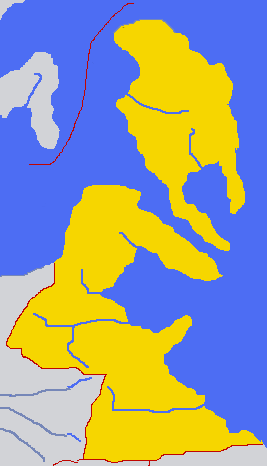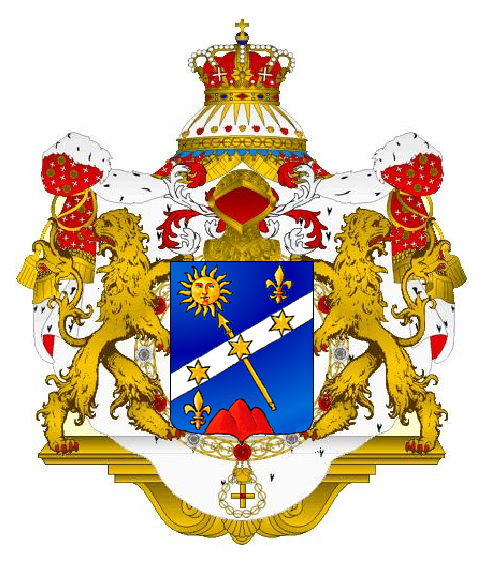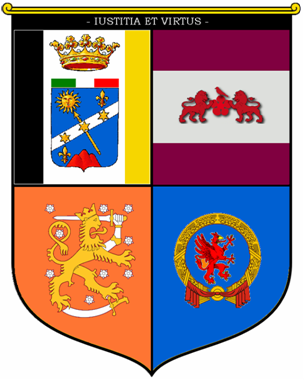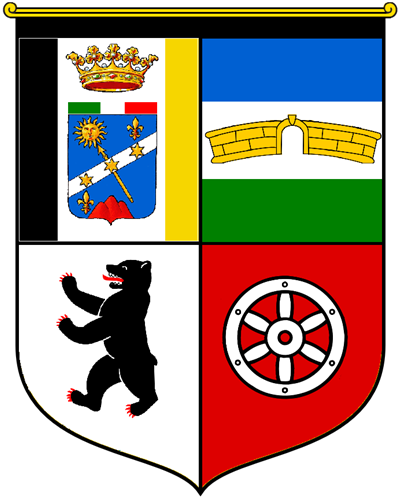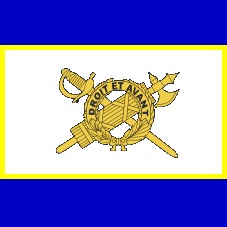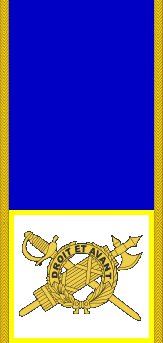Difference between revisions of "Nasuti"
(→Forze Armate di Nasuti) |
(→Forze Armate di Nasuti) |
||
| Line 548: | Line 548: | ||
See also... [[Forze Armate di Nasuti]] | See also... [[Forze Armate di Nasuti]] | ||
| − | [[Category:Nations | + | [[Category:Nations]] [[Category:Nasuti Factbooks]] |
Revision as of 17:31, 26 June 2007
| Principato Romano Cattolico di Nasuti | |
|---|---|
| Motto - English |
motto in latin? motto in english? |
| Anthem | Ira Tenax (Listen) |
| Official Language(s) | Italian, Lancianese |
| Capital | Roccaforte di Nasuti |
| Government | Hereditary Monarchy |
| Title | His Catholic Majesty Prince |
| Leader | Cris I of the Sovereign Royal Family of Nasuti |
| Population at 16/07/2007 |
- 768 milion |
| Establishment - Foundation of Samnium - Municipium of Anxianum - League of Samnium - Domination of Lanciane - Coronation of 1st King - Constitutional Monarchy - Complete Kingdom - Roman Catholic Princedom |
- 1100 b.C. - 132 b.C. - 1112 - 1572-1715 - 1780 - 1890 - '50s - 2007 |
| Area - Area - % water |
xx km. sq. xx% |
| National Colors | Black, Gold Yellow and White |
| GDP - Total (USD) - Per Capita (USD) |
$4,710,962,981,734 $6,134 |
| Currency | Lira del Camerlengo |
| Exchange Rate | 1 Lira del Camerlengo = $0.45 |
| Tech Level | Post Modern Tech |
| Patrons | - Madonna del Carmine - Santa Lucia - San Gabriele - Sant'Amato |
| National sport(s): | car races on circuit, soccer, swim |
| Stats: NS NSEconomy NSTracker Sunset Pipian XML | |
Contents
- 1 Principato Romano Cattolico di Nasuti
- 2 Story of Nasuti
- 3 Sovrana Famiglia Reale di Nasuti
- 4 Politics and Government
- 5 Geography of Nasuti
- 6 Nasuti's administrative division
- 7 Religion
- 8 Police of Princedom
- 9 Emergencies and Rescue Management Corp
- 10 Volontaries for Red Cross of Princedom
- 11 Civil Life
- 12 Forze Armate di Nasuti
Principato Romano Cattolico di Nasuti

Principato Romano Cattolico di Nasuti (The Roman Catholic Princedom of Nasuti) is a Nation of the region Catholic, member of UN, member of Catholic Council and signer of the Catholic Charter. The capital city is Stronghold of Nasuti, a town built around to a medieval fortress. The Roman Catholic Princedom of Nasuti refer itself whit short form Nasuti.
The official language of the Nasuti is Italian, but a lot citizen speak (not exist a reference text for coding the writing) an ancient language called "Lancianese" native of the ancient domination that the Princedom was submitted.
Nation's adjectival form is Nasutian (Nasutere in Lancianese) and and it is the same for noun for persons from this nation.
The population is of about 760 millions, but the continuous growth carries the analysts to indicate the achievement of 1 billion within the end of the year 2007.
Major ethnic groups is Italic Nasutian (95%), German (2%), English (2%), French (0.5%) and Polish (0.5%).
The Holy Flag of the Principato Romano Cattolico di Nasuti is, from left to right, black, white and gold yellow, with the coat of arms of the Sovereign Royal Family on the white cloth.
Story of Nasuti
From foundation to Lanciane's Domination
The story and the legend tells that the first village of the Princedom was Samnium, whose origin comes make go back around 1100 BC. Subsequently in Roman period the villages became a colony of the Republic, with the name of Castra Samnium. Castra Samnium became Municipium in 132 b.C. with the name of Anxianum and it had this status until the barbaric invasions. Whit the statal reform of Augustus Regio Samnium became the name of the region under the controll of Anxianum.
With the arrival of the first Christian evangelist, the populations of the region converted themselves immediately to the Christianity, recognizing the True God and the True Faith. The Christian community had immediately lively exchanges with the Bishops of Rome and did not embrace any heretical theory of paleo-Christian period.
During fall of the Western Roman Empire, the Samnium Region was sacked by the Goths, and Anxianum was partially destroyed during the Lombard invasion (c. 570 AD). In 610, however, the region was conquered by the Byzantines, who found the Ducato di Samnium (Duchy of Samnium) and allowed the trades to restart. In the late 8th century the Duchy was conquered by the Franks, who fight against the Muslim pirates with the precious help of the people of the region.
In 9th century the Duchy divided themselves and Anxianum returned independent with the name of Anxano Sannita. In the medieval age in all of the region came built some outposts fortified, particularly the most large it was the Fortezza del Samnium (Fortress of the Samnium) in the Anxano Sannita and a new settlement was then created around the castle.
In 1060 the Normans made the region a centre of trade and Anxano Sannita receiving important privileges by both Frederick II and his son Manfred, with a substantial administrative autonomy. With a new period of development and of flowering of the commerce, the region expanded themselves until to occupy almost all of the current area, with the annexation in the sphere of influence of the territories of Rizzacorno, Riegne, and Feltrin, left after the barbaric invasions and now returned to shine thanks to the commerce. The power was managed from noble faithful to the Holy Roman Empire but during the conflict between Pope and the Empire, although the noble are lined up with the Emperor, the people rhymed faithful to the Pope. In 1112, after hunted it of the "unfaithful noble", many territory of the region (Castello Frentan, Teate, Solomona, Villa Ripa) decided to unite with Anxano Sannita in a commercial and politic union called Lega del Samnium (League of Samnium) that give a reasonable independence. Many free citizens of the league enlisted voluntarily to participate at the Crusades for the liberation of the Holy Land and, besides in middle east, they should confront the Muslim also on the native ground, threatened by the continuous raids.
The independence, the privileges and the commercial riches developed still of more in the Renaissance collapsed with the civil war against the Ducato di Lanciane (Duchy of Lanciane), that invaded all the member of the League in 1572 and subjected it until the 18th century. The new dominator governed with iron fist and despotism, until the crash with some of the religious authority of the region. However under the domination fermented the seeds of the revolution and more times local rebellions had been suffocated in the blood. In 17th century also the Duchy was devastated from the plague and economical crisis became more strong contributing to the growth of the popular discontent. Track of the dark period of the domination is remained only in the language speak by a lot citizen, without hatred for the inhabitants of Lanciane. In fact, with the increase of rebellions, the Duchy began to fall in a more internal deep crisis and to the moment of the definitive crash, fortunately, the people of dissolved dominator and their brothers of the new Kingdom have chosen the way of the reconciliation in Christ.
The Rebellion an the Kingdom
In 1715 began the general rebellion that carried first to the rebellion of all of the people against the Duchy and then to the independence of the community. The rebellion was driven from some limb of the people and from some old noble noble of the pre-domination: with a series of committees they drive the rebels to the victory with the minimum crashes and convincing also the original citizens of the Duchy. After the victory, for the temporary government, was created an assembly of heroic rebels and wise, the Concilio dei Saggi e dei Coraggiosi (Council of Sages and Braves). After little years the Council decided to create an united kingdom where could adhere all the local regions. The sovereignty had entrusted to the family of the most courageous commander of rebellion, Lord Ferdinando Domenico Nasuti Barone della Roccaforte di Anxano (Baron of Stronghold of Anxano, the new name of Anxano Sannita).
The first one King was Nicola I the Great, grandchild of Ferdinando Domenico, crowned Re del Samnium (King of Samnium) in 1780. His father, Domenico Nasuti, was a member of Council for 25 years and Chief of Council for his last 5 years of life; he proposed the idea of a Kingdom 20 years before the coronation of his son. Nicola I, admirer of the struggle for the independence of the USA and of their constitutional democracy, basins the first democratic Constitution that established the power of the King and the power of the Council of Sages and Braves. He fixed the capital in Roccaforte di Anxano and he consolidated the absolute relations of faithfulness to the Pope and to the Roman Catholic Church with an agreement and oath both valid for all of the its sovereigns successors.
During the kingdom of Ferdinando I the Charitable and Gildo I the Just, the trouble of death was progressively abolished and was founded the Congregazione per la Legge dei Laici (Congregation for the Law of the Laymen) for the management of the justice. Besides also in the kingdom appeared the industrial revolution, that in little years fixed the economy of the region and carried the economical development to a level ever reached first without the exploitation of the proletariat thanks to the farsighted application of the social doctrine of the Church forced by the Sovereigns and the religious authority.
In 1890 King Gildo III the Reformer decided to substitute the Council of Sages and Braves with the Senato dei Fedeli (Senate of the Faithful) and reform the state establishing the present type of government (with the division of the power betweeen the King, the Senate of the Faithful and the Congregation for the Law of the Laymen); the last session of the Council of Sages and Braves decided to change the name of the Kingdom with the name of sovereign family: the Kingdom of Samnium became the Monarchia Costituzionale di Nasuti (Constitutional Monarchy of Nasuti). The Kingdom did not participate to the World Wars I.
In 1930, for the 150th anniversary of the coronation of Nicola I the Great and of the kingdom of the Nasuti, King Domenico I and the Senate of the Faithful approved the change of the name of the capital in Roccaforte di Nasuti.
King Domenico II the Peaceful guaranteed the neutrality of the kingdom during World Wars II and the neighboring indipendent regions of Gaeta and Costa di Teate asked of to be annas to the kingdom.
King Raffaele I and his son Nicola II inaugurated the season of the "short and modern kingdom": both after little years of kingdom have abdicated in favor of the sons. In 1980, after little months from its coronation, the King Nicola II celebrated the 200th anniversary from the coronation of its homonymous predecessor Nicola I. In 200 years it was ensured to the Kingdom the peace and the calm, the development and the well-being. Some intellectual of the Nation advanced the idea of a "Pax Nasuti", but the King denied his support to this conviction remembering that the "only peace is in Christ and not in the men".
After the abdication of King Nicola II, the King Cris I announced a referendum that changed the Constitutional Monarchy to Princedom, taking again in part the ancient title of "Roman Catholic". The new name is the current: Principato Romano Cattolico di Nasuti (Roman Catholic Princedom of Nasuti). The Pricnipe Cris I has wanted the presence of its two enlightened predecessors to its flank in the government of the Princedom.
Sovrana Famiglia Reale di Nasuti
The Sovrana Famiglia Reale di Nasuti (Sovereign Royal Family of Nasuti) is a dynasty of nobles who descend from Lord Ferdinando Domenico Nasuti Baron of Stronghold of Anxano, the most courageous one of the commanders of rebellion of 1715.
The 1st King was Nicola I the Great, grandchild of Ferdinando Domenico, crowned King of Samnium in 1780.
In 1890 the Kingdom of Samnium became the Constitutional Monarchy of Nasuti.
In 2007, after a referendum, became Roman Catholic Princedom of Nasuti, and the King of Nasuti became Price.
The Residences of the Sovereign Royal Family of Nasuti is Fortezza di Samnium in the capital Roccaforte di Nasuti.
Chronology of the Sovereign Royal Family
| Chronology of the sovereign family | |||||||
|---|---|---|---|---|---|---|---|
| Head of the household | Born | Crowned | Dead | ||||
| Baron Ferdinando Domenico Nasuti | 15/09/1682 | no crowned | 21/04/1745 | ||||
| Baron Domenico Nasuti | 08/07/1712 | no crowned | 13/03/1761 | ||||
| King Nicola I the Great, 1st King | 10/06/1735 | 01/01/1780 | 5/08/1790 | ||||
| King Ferdinando I the Charitable | 01/02/1760 | 15/08/1790 | 30/11/1833 | ||||
| King Gildo I the Just | 23/05/1792 | 10/12/1833 | 12/08/1856 | ||||
| King Gildo II the Elder | 05/04/1818 | 22/08/1856 abdicated in 1886 | 23/05/1898 | ||||
| King Gildo III the Reformer | 20/12/1847 | 01/01/1887 | 03/01/1921 | ||||
| King Domenico I | 02/08/1873 | 13/01/1921 | 15/10/1925 | ||||
| King Domenico II the Peaceful | 18/07/1902 | 25/10/1925 | 15/04/1964 | ||||
| King Raffaele I | 24/01/1924 | 25/04/1964, abdicated in 1978 | |||||
| King Nicola II | 28/12/1955 | 01/01/1979, abdicated in 2004 | |||||
| King Cris I | 06/09/1980 | 01/01/2005, became 1st Prince in 2007 | |||||
Rules for the succession to the throne
After the death of the Sovereign, are expected 10 days of national mourning. The 11th day after there is the coronation of the new Sovereign.
The heir of the throne is the 1st male son.
If the dead Sovereign has not male heirs, the throne goes to the eventual female son.
If the dead Sovereign has not heirs, the throne goes to his brother and his lineage with precedent regulates.
If the dead Sovereign has not brothers, the throne goes the eventual his sister.
If the dead Sovereign has not sisters, the throne comes declared vacant and the Senate must name in 60 days a new Sovereign between the heirs of those who distinguished in the story of the Kingdom from the times of the rebellion.
The Sovereign can renounce only in favor of a son heir, even if he is not the first male.
Are not allowed passages of throne to uncle and aunts, cousins, nephew and niece, ancestors and other relations over first degree of kinship.
Titles of the Crown
Sua Maestà Cattolica Principe Cris I, per Grazia di Dio e Volontà della Nazione, Principe del Principato Romano Cattolico di Nasuti, erede di Ferdinando Domenico Nasuti comandante della ribellione e del Re Nicola I il Grande e di tutti i Pater Patriae, Guardiano e Protettore della Santa Chiesa Romana Cattolica, Barone della Roccaforte di Nasuti, Principe di Samnium, Domine di Castel Frentan, Signore Supremo di Teate e Solomona, Nobile Patrizio di Villa Ripa, Conte Vicario Perpetuo di Feltrin, Riegne e Rizzacorno, Signore Protettore di Valle del Carmelo, Duca Vicario Perpetuo di Lanciane e Gaeta, Signore del Mare di Costa di Teate.
His Catholic Majesty Prince Cris I, by the Grace of God and the Will of the Nation, Prince of The Roman Catholic Princedom of Nasuti, heir of Ferdinando Domenico Nasuti commanders of the rebellion, heir of King Nicola I the Great and of all Pater Patriae, Guardian and Protector of the Holy Roman Catholic Church, Baron of Stronghold of Nasuti, Prince of Samnium, Domine of Castle Frentan, Overlord of Teate and Solomona, Noble Patrician of Villa Ripa, Perpetual Vicar Count of Feltrin, Riegne and Rizzacorno, Lord Protector of Valley of Carmelo, Perpetual Vicar Duke of Lanciane and Gaeta, Master of Sea of Coast of Teate.
Politics and Government
Nasuti is a Constitutional Princedom with separation of powers: legislative to the Senato dei Fedeli (Senate of the Faithful); executive to the hereditary Prince with title of Sua Maestà Cattolica Principe (His Catholic Majesty Prince); justice to the Congregazione per la Legge dei Laici (Congregation for the Law of the Laymen).
Head of State is Sua Maestà Cattolica Principe Cris I (His Catholic Majesty Prince Cris I) and his vice is Bishop or Cardinal of the diocese named by the Pope.
Executive Branch
Head of Government is also the Prince, but he personally choise only a little part of the executive (Interior and Defense, Foreign Relationship, Treasury), while remaining is elected for 5 years with free universal votes between all of the Citizens with more of 20 years. The Prince and the member of executive not have the power to dismiss or give orders to Senators or to Judges, but the Prince choise the Chief of Justice of the Congregation for the Law of the Laymen.
The Prince have the supreme power over the member of Government choise by itself, but He can't dismiss the elected ministers; He authorizes or rejects the measures of the government and He is last responsible for the government facing God, people and history. The Prince can't introduce bills, but he has the power to veto acts of the ministers or of the legislature.
Every minister is responsible for his matter and He is occupied only of the politics that compete them. They can introduce measure only on their matter; they can only propose bills to Senate. The measure that involve all of the government require the favorable vow of the majority of the ministers and the approval of the Prince. Can become minister all of the pratice catholic citizens than have more of 30 years and that lend public profession of faith. When an elected minister resign, there is the election of a substitute.
Members of the current Government:
- His Catholic Majesty Prince Cris I of the Sovraign Family Nasuti;
- Minister of the Interior and of the Defence: Distinguished Prince Nicola II, chosen by the Prince;
- Advisors of the Prince for the Foreign Relationship: Duke Aldo and Dukess Patricia of Gaeta, chosen by the Prince; the Prince treats personally the diplomatic relationship with the foreign countries;
- Minister of the Treasury: Sara Battisti Countess of Castle Frentan, chosen by the Prince;
- Chief of the Integrated Catholic Educational System: Bishop or Cardinal of the capital diocese;
- Minister for the Free Information: Azzurra Renati Countess of Feltrin, elected;
- Minister for the Science, Technology, Reserch and Development: Engineer Faby Iana Countess of Riegne, elected;
- Minister of Transportation: Professor Riccardo Ricciuti, elected;
- Minister of Communications: Engineer Maria Elena Annecchini, elected;
- Minister of Works and Solidarity: Carmine Della Franca, elected;
- Minister of Health and Social Affairs: MD Professor Silvio Da Loreto;
- Minister of Primary Sector and Environment (agriculture, food, fishing, rural affairs, natural heritage): Luigi di Campli, elected;
- Minister of Culture: Federico Ferraro Marquis of Carmelo, elected;
Legislative Branch
The Senate of the Faithful is composed from 100 elected Senators and maximum 10 Senators to life named from the Prince. Can become Senators all of the pratice catholic citizens than have more of 30 years and that lend public profession of faith.
The Senate proposes, discusses and approves the ordinary bills. The constitution can be changed only with the authorization of the Prince.
The Senate comes elected every 5 years with universal vote between all of the Citizens with more of 20 years.
In 1st sitting the Senators elect Cancelliere del Senato (Chancellor of Senate) from the Senators to life. The Chancellor presides over, moderate and rule the activity of the Senate. He develops its assignment impartially and lose the right of vow in hall and of to propose laws.
Every proposal of the Senate must be voted by all Senators and it's approved if get the majority vote (50%+1 of Senators).
The Senate haven't the power to dismiss or give orders to Prince or to ministers or to Judges and can't rule the decison and the composition of the Nasuti's Establishment or the Costitutional form without the authorization of the Prince.
Justice Branch
The Congregation for the Law of the Laymen is the civil responsable for the justice. Is lead by Capo della Giustizia (Chief of Justice) chosen by the Prince; currently Chief of Justice is the Distinguished Prince Raffaele I.
Can ask to become Judges of the Congregation only the citizens graduated in law and that attend and pass the Corso Superiore di Formazione Legale (Superior Legal Formation Course) organizated by the Congregation: between all the candidates, only the better 25 of the year can obtain the appointment to Candidate Judge. After 5 years of pratice in the varied seats of the Congregation, if a Judge Junior pass the Esame dei Maestri della Giustizia (Examination of the Master of Justice), becomes regular Judge of the Congregation.
Every Judge is indipendent in his activity but answer to the Chief of justice for his sentence and behavior.
Coats of arms of the Establishment
Geography of Nasuti
The territories of Nasuti are the mainland in south and a big island Sabina Superba in north. Nasuti is surrounded in north and east by the waters of Mare Samnium (Samnium Sea).
The north-east coast is dominated by the Distesa Sabinica Superiore (Upper Sabinic Expanse), that it is extended until the Panisola Rizza (Peninsula Rizza) on south-east of the island. Into north of the island, behind the Distesa Sabinica Superiore, there it is the mountainous massif of the Aldana, where is the woodland park of Gaeta around the mount. In the central weast part of the island there is the river Feltrin that go to sea from the mount of Corno (in central east part of the island) to the west in the Piana Feltrina (Feltrina Plain), the biggest fluvial plain of the island. Under the Piana Feltrina, in south west, there are the plain of Distesa Sabinica Inferiore (Lower Sabinic Expanse) that it is extended until the Penisola Ripa (Penisula Ripa) in the south-west, the longest peninsula of the island. From the Corno come down to south the river Trino, that flow in the water of the Golfo di Cesia (Cesia's Gulf), the gulf between the two peninsulas.
The north-western part of the north mainland is occupied by the Piana Marittima Teatina (Teate's Maritime Plain), while in east there is the Penisola Cimanica (Cimanic Peninsula) that is separated from the island by the waters of Stetto Julianico (Julianic Strait). Behind the Piana Marittima Teatina, at the center of north part of the mainland, there is the mount Cimana from that it gushes the river Lia. Between this river and the parallel Pia, to south, it is extended Piana Seroli (Plain Seroli). Under the Pia there is the Piana del Sangro (Sangro's Plain), terminated in south by the Sangro and its first tributary Majico that gushes from the mount Carmelo in the extreme east. Between the Carmleo at east, the river Majico at north and river Goltico at south, there is the Valle del Carmelo (Carmelo's Valley). Goltico is the second tributary of the Sangro and the pair of river sourround Piana del Goltico (Goltico's Plain), that is limited, at south, by the mount Golgon where gushes the Goltico. From the mountainside to the sea there is the Penisola Franca (Peninsula Franca). Along the remaining southern coasts there is Piana Marittima di Carolina (Carolina's Maritime Plain), while the inside territory is horizontally cut by the river Anxan, that gushes from the south side of the Golgon. Finally in the south boundary of Nasuti there are the Valli Meridiane (Meridian's Valleys), the valleys of the mount Corno Meridia, the extreme south boundary of Nasuti.
Nasuti's administrative division
The Princedom is divided in 12 Regions, with a limited local autonomy, derived from the ancient territories of the Regio Samnium. In the north island Sabina Superba there are 5 region: Ducato di Gaeta (Duchy of Gaeta), Contea di Riegne (County of Riegne), Contea di Feltrin (County of Feltrin), Contea di Rizzacorno (Earldom of Rizzacorno) and Villa Ripa. In the south, on mainland, there are other 6 regions and the capital district: Costa di Teate (Coast of Teate), Solomona, Teate, Samnium (capital district), Valle del Carmelo (Valley of Carmelo), Castello Frentan (Castle Frentan) and Ducato di Lanciane (Duchy of Lanciane).
The first territorial unit of the Princedom, that sinks his roots in the League of Samnium, is managed from local officials directly elected from the citizens. This type of region are Castello Frentan, Teate, Solomona, Villa Ripa, and Valle del Carmelo. Costa di Teate, before the union with the Princedom, was a republic and maintained part of the republican structures for the local administration. The Ducato di Gaeta, like Costa di Teate, after the union with the Princedom maintained also its administrative equipment governed by the Duca di Gaeta. The thre County, Rizzacorno, Riegne and Feltrin, also are managed by the respective noble families with a part of the officials elected by the citizens. Finally the Ducato di Lanciane maintained its nobility only in name. The old lords of the period of the oppression have not heirs and the Duchy is passed between different noble families of the region. Besides its administrative structure is totally elective except for the leading of the local government that is entrusted to the ducal family. While the other regions enjoy of a reasonable administrative autonomy, Samnium is a special region than has not a self-govern because traditionally was the heart of the Kingdom and today is the leading power center of the Princedom.
See also... Nasuti's administrative division
Religion
The religion is a fundamental appearance of the life of the state and of the citizens. The Official State Religion is Roman Catholic (professed by 99% of citizens): Nasuti is a nation of Christians loyal to the traditions of the Roman Catholic Church and obedient to Supreme Pontiff Pope Benedict XVI. The Nasutian are faithful to the moral and to the teachings of Jesus Christ and of His Church.
Other Religions is professed by 1% and to them is guaranteed the freedom of religion and the independence from Catholic Church authority with special law.
Police of Princedom
Police of Princedom is a civil agencies empowered to use force and other forms of legal coercion and legal means to effect public and social order. The Police of Princedom responsability is of Minister of the Interiors and of the Defence and he is subordinated to the authority of the Prince.
The police agents are authorized to exercise the police power in all Princedom, but they are belonged to different Regional Departments. Regional Departments are divided in Urban Departments (for major cities and suburbs) and Territorial Districts (for minor cities or rural area).
Police Ranks
Police Uniforms
Emergencies and Rescue Management Corp
Emergencies and Rescue Management Corp (Corpo di Gestione delle Emergenze e dei Soccorsi, CGES) is a regular civil corp for the management of emergencies and rescue, like natural disasters, fire, situations of danger for the civilians, etc.
CGES's purpose is to coordinate the response to an emergencies and rescue which has occurred in the Princedom. On-the-ground support is a major part of CGES's activity, but the agency provides experts in specialized fields and funding for rebuilding efforts and relief funds for individual citizens and infrastructure, in conjunction with the public administration. CGES also assists individuals and businesses with low interest loans and also provides funds for training of response personnel throughout the Princedom.
In past the tasks of the CGES had entrusted at different public departments managed by the local authority, armed forces and health service. Only in the 1950's the government decided to create a national corp that it is occupied specified of emergencies and rescues.
Volontaries for Red Cross of Princedom
Volontaries for Red Cross of Princedom (Volontari per la Croce Rossa del Principato, VCRP) is a humanitarian organization that provides emergency assistance, disaster relief and education inside the Princedom, as part of the IFRC.
Today, in addition to domestic disaster relief, the VCRP offers compassionate services in five other areas: community services that help the needy; support and comfort for military members and their families; the collection, processing and distribution of lifesaving blood and blood products; educational programs that promote health and safety; and international relief and development programs.
Governed by volunteers and supported by community donations, the VCRP is a nationwide network dedicated to saving lives and helping people prevent, prepare for and respond to emergencies. Volunteers and employees relief to families affected by disasters, train many people in lifesaving skills and exchange emergency messages for military service personnel and their families. The VCRP also assists victims of international disasters and conflicts at locations worldwide.
Civil Life
Familiar politics
In the 1970s , while the big part of the world proceeded with the approval of rules for the demographic control, the government of the Princedom decided to apply a politics against tendency that they aimed to the protection of the families and to their development. They were introduced familiar cheque for the sons, introduced the system of taxation based on the familiar quotient, favored the opening of nursery school for the son of couples of workers, etc.
After almost 30 years of application, the Prince Cris I declared to is not intentioned to leave this politics but, contrariwise, will invest even more resources.
Thanks to the politics of the Government for the protection of the family and the development of the population, the Princedom of Nasuti had celebrated at the beginnings of June the achievement of 700 millions of inhabitants and be learned to reach the billion before the end of the year 2007 (actual esteem: october 2007).
School
In Nasuti the education entrusted by the Integrated Catholic Educational System:
- Nun's Nursery Pubblic School for Childhood and Babyhood or privates nursery, voluntary from 0 to 5 year; - Jesuit Catholic School, obligatory from 5 to 18 year; - Catholic University;
After the protests of a group of not Catholic, in 1905 the government established that for not Catholic there is voluntary abstention from some disciplines, to replace with other choices from the Gathering for the Law of the Laymen.
Anthem: Ira Tenax
Male sit tibi tenebrarum rex
ab initio ad finem sacra ultio
cruenta pugna et epicus furor
contra mali discipulos
Ad perpetuam gloriam lucis
furor ira tenax
contra iniuriam et ruinam
rabies ira tenax
Male sit tibi tenebrarum rex
cruentus rex
(Luca Turilli ed Alessandro Staropoli)
Forze Armate di Nasuti
The Forze Armate di Nasuti (FAN, Military Forces of Nauti) include all military of the Princedom and are lead by Comandante Supremo capo delle Forze Armate (CSFA, Supreme Commandant chief of the Military Forces) William Adama, chosen from Prince Nicola II when it governed and maintained in service from Prince Cristian I for military merits. the Supreme Commandant has a partial autonomy but obeys directly to the Prince.
An esteem (the number is not precise for the secret composition of some special departments) attributes to the FAN as regular fighting enlisted and trained 0.25% of population.
The Constitution and the moral of Nasuti expects the use of the FAN only for defend the Nation and its allies, but refuses the use of the force like tool of aggression and submission.
See also... Forze Armate di Nasuti



